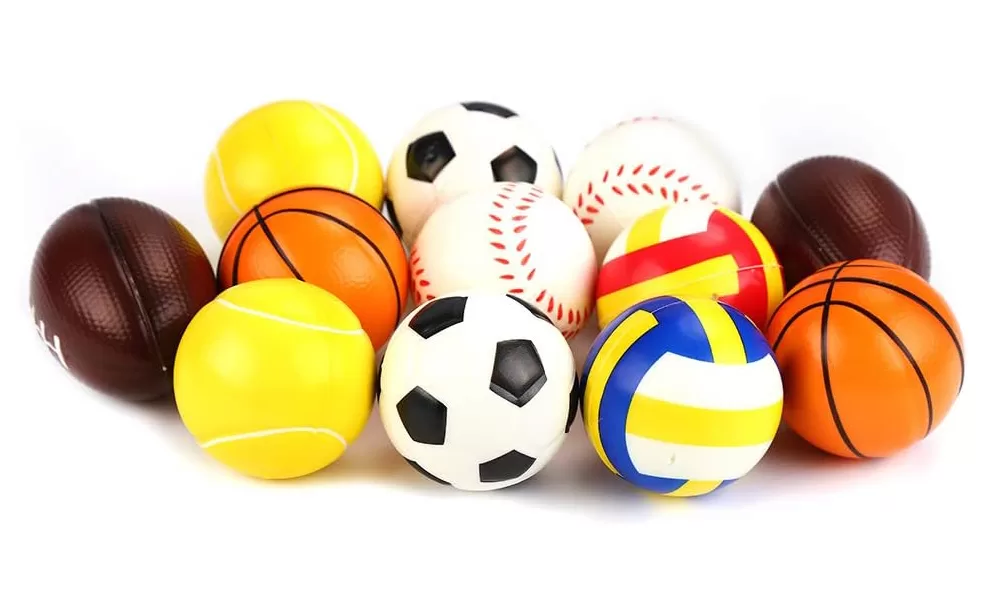
폼 및 스펀지 볼 소개
폼 볼과 스펀지 볼의 차이점을 자세히 알아보기 전에 먼저 각 볼이 무엇인지 이해해 보겠습니다.
폼볼이란 무엇입니까?
폼 볼은 폼 재료로 만든 볼 유형입니다. 이러한 재료에는 폴리우레탄, 폴리스티렌 또는 기타 유형의 폼이 포함될 수 있습니다. 폼은 공 모양이며 다양한 재료로 덮어서 다양한 질감과 모양을 제공할 수 있습니다. 폼 볼은 가볍고 제작에 사용되는 작은 볼부터 스포츠나 물리 치료에 사용되는 큰 볼까지 다양한 크기로 제공됩니다. 그들은 종종 밝은 색을 띠고 게임, 공예, 운동을 포함한 다양한 활동에 사용될 수 있습니다.
스펀지볼이란 무엇인가요?
스펀지볼은 이름에서 알 수 있듯이 스펀지 같은 재질로 만든 공입니다. 이러한 재료에는 천연 스폰지, 셀룰로오스 또는 기타 유형의 흡수성 재료가 포함될 수 있습니다. 스펀지볼은 부드럽고 쫄깃하며 물을 많이 흡수할 수 있습니다. 따라서 공이 사라졌다가 다시 나타나야 하는 수중 게임이나 마술에 적합합니다. 스펀지 볼은 크기와 색상도 다양하며 게임과 트릭부터 청소 및 문지르기에 이르기까지 다양한 활동에 사용할 수 있습니다.
핵심 차이점
이제 폼 볼과 스펀지 볼이 무엇인지 정의했으므로 핵심 차이점을 살펴보겠습니다.
재료 구성
폼 볼과 스펀지 볼의 재료 구성은 이들 사이의 주요 차이점 중 하나입니다. 폼 볼은 일반적으로 폴리우레탄이나 폴리스티렌과 같은 합성 재료로 만들어집니다. 이러한 소재는 공에 가볍고 견고한 구조를 제공합니다. 반면, 스펀지볼은 천연 또는 합성 스펀지 소재로 만들어집니다. 이 소재는 흡수성이 뛰어나 공에 부드럽고 질긴 질감을 제공합니다.
질감과 느낌
폼볼과 스펀지볼의 질감이나 느낌도 사뭇 다릅니다. 폼볼은 부드럽고 단단하며 약간 탄력 있는 느낌을 줍니다. 가벼워서 쉽게 던지거나 튕길 수 있습니다. 반면에 스펀지 볼은 부드럽고 질척질척하며 쉽게 압축할 수 있습니다. 그들은 더 유연한 느낌을 가지며 많은 물을 흡수할 수 있습니다.
바운스와 유연성
폼과 스펀지 볼의 바운스와 유연성은 또 다른 주요 차이점입니다. 폼볼은 견고하고 가벼운 구조로 인해 바운스가 더 높습니다. 유연성이 떨어지고 쉽게 압축할 수 없습니다. 그러나 스펀지볼은 부드럽고 질척거리는 질감으로 인해 바운스가 낮습니다. 더 유연하고 쉽게 압착하거나 압축할 수 있습니다.
내구성과 수명
내구성과 수명 측면에서 폼볼이 스펀지볼보다 오래가는 경향이 있습니다. 폼 볼은 내구성이 더 뛰어나고 더 많은 마모를 견딜 수 있습니다. 손상에 덜 민감하며 적절한 관리를 통해 오랫동안 지속될 수 있습니다. 스펀지 볼은 내구성도 있지만 흡수성 특성으로 인해 더 빨리 마모될 수 있습니다. 물의 지속적인 흡수 및 방출로 인해 시간이 지남에 따라 스펀지 재료가 분해될 수 있습니다.
용도 및 응용
폼과 스펀지 볼은 특성이 다르기 때문에 용도와 용도가 다릅니다. 폼볼은 스포츠, 공예, 치료에 흔히 사용됩니다. 견고함과 내구성으로 인해 많이 튀거나 던지는 활동에 적합합니다. 스펀지볼은 흡수력이 좋고 질척거리는 특성을 갖고 있어 수중 게임과 마술에서 인기가 높습니다. 또한 흡수성으로 인해 청소 및 문지르기에도 사용할 수 있습니다.
장점과 단점
모든 동전에는 양면이 있으며 폼과 스펀지 볼도 마찬가지입니다. 그들의 장점과 단점을 살펴보겠습니다.
폼볼의 장점
폼볼에는 몇 가지 장점이 있습니다. 가볍고 내구성이 뛰어나며 다재다능합니다. 스포츠와 게임에서부터 공예와 치료에 이르기까지 다양한 활동에 사용될 수 있습니다. 단단하고 탄력 있는 질감으로 가지고 놀기 재미있고, 내구성이 뛰어나 오랫동안 사용할 수 있습니다.
폼볼의 단점
장점에도 불구하고 폼볼에는 몇 가지 단점도 있습니다. 스펀지 볼만큼 유연하거나 흡수성이 없어 사용이 제한될 수 있습니다. 일부 활동이나 게임에는 너무 단단하거나 탄력이 있을 수도 있습니다.
스펀지볼의 장점
스펀지 볼에도 몇 가지 장점이 있습니다. 부드럽고 유연하며 흡수성이 뛰어납니다. 물놀이, 마술, 청소, 문지르기 등 다양한 활동에 사용할 수 있습니다. 부드럽고 질척질척한 질감으로 가지고 놀기에 재미있고, 흡수력이 뛰어나 청소와 문지르기에 유용합니다.
스펀지볼의 단점
그러나 스펀지 볼에도 몇 가지 단점이 있습니다. 흡수성 특성으로 인해 폼 볼만큼 오래 지속되지 않아 마모가 더 빨리 발생할 수 있습니다. 또한 폼 볼만큼 단단하거나 탄력이 없어 사용이 제한될 수 있습니다.
올바른 선택
폼 볼과 스펀지 볼 중에서 선택하는 것은 궁극적으로 특정 요구 사항과 용도에 따라 달라집니다. 튀거나 던지는 운동이 많이 필요한 스포츠나 게임에 공이 필요하다면 폼볼이 더 나은 선택이 될 수 있습니다. 물놀이, 마술, 청소 등을 위해 공이 필요하다면 스펀지볼이 더 나은 선택일 수 있습니다. 각 유형의 공의 장단점을 고려하고 특정 요구 사항에 따라 정보를 바탕으로 결정을 내리세요.

폼과 스펀지 볼이 환경에 미치는 영향
폼 볼과 스펀지 볼은 모두 고유한 특성과 용도를 가지고 있지만 환경에 미치는 영향을 고려하는 것도 중요합니다. 폼 볼, 특히 폴리스티렌과 같은 합성 재료로 만든 폼 볼은 분해되는 데 수백 년이 걸릴 수 있어 심각한 환경 문제를 야기합니다. 반면, 특히 천연 소재로 만든 스펀지 볼은 생분해성이고 환경에 미치는 영향이 적습니다. 그러나 합성 스펀지는 환경 오염의 원인이 될 수도 있습니다. 따라서 폼 볼과 스폰지 볼 중에서 선택할 때 환경 발자국을 고려하는 것이 중요한 요소가 될 수 있습니다.
폼 및 스펀지볼 제조의 혁신
폼과 스펀지 볼의 제조 공정은 수년에 걸쳐 상당한 발전을 이루었습니다. 폼 볼의 경우, 혁신을 통해 다양한 밀도와 견고성을 지닌 볼을 생산할 수 있게 되었으며 더 넓은 범위의 적용이 가능해졌습니다. 스펀지볼의 경우 제조기술의 발전으로 흡수력이 향상되고 내구성이 향상된 스펀지볼이 탄생하였습니다. 이러한 혁신은 볼의 용도를 확대했을 뿐만 아니라 성능과 수명도 향상시켰습니다.
건강 및 안전 고려사항
폼과 스펀지 볼은 일반적으로 사용하기에 안전하지만 특정 건강 및 안전 고려 사항을 염두에 두어야 합니다. 예를 들어, 특정 유형의 합성 재료로 만든 폼 볼은 특히 분해되기 시작할 때 유해한 화학 물질을 방출할 수 있습니다. 따라서 폼볼에 독성 물질이 없는지 확인하는 것이 중요합니다. 마찬가지로 스펀지 볼은 흡수성이 높기 때문에 적절하게 세척하고 건조하지 않으면 박테리아의 온상이 될 수 있습니다. 따라서 건강상의 위험을 예방하려면 스펀지 볼을 정기적으로 청소하고 적절하게 유지관리하는 것이 필수적입니다.
자주 묻는 질문
스펀지볼보다 폼볼이 더 좋나요?
특정 용도에 따라 다릅니다. 폼볼은 내구성이 뛰어나고 단단해 스포츠와 공예에 적합합니다. 스펀지 볼은 부드럽고 흡수성이 뛰어나 수중 게임과 마술에 적합합니다.
폼볼 대신 스펀지볼을 사용해도 되나요?
항상 그런 것은 아닙니다. 어떤 경우에는 서로 바꿔서 사용할 수 있지만 속성이 다르기 때문에 다양한 응용 프로그램에 더 적합합니다.
폼볼은 어린이에게 안전한가요?
네, 폼볼은 가볍고 부드럽기 때문에 일반적으로 어린이에게 안전합니다. 그러나 작은 폼볼은 질식의 위험이 있으므로 어린 어린이 주변에서는 주의해서 사용해야 합니다.
스펀지볼은 어떻게 청소하나요?
스펀지 볼은 따뜻한 비눗물에 담가서 부드럽게 먼지를 짜내고 완전히 헹군 후 자연 건조시켜 청소할 수 있습니다.
폼과 스펀지 볼은 어디서 구입할 수 있나요?
폼 및 스펀지 볼은 스포츠 매장, 공예품 매장, Amazon과 같은 온라인 마켓플레이스 또는 제조업체에서 직접 구매할 수 있습니다.

결론
결론적으로 폼볼과 스펀지볼은 얼핏 비슷해 보이지만 소재 구성, 질감, 촉감, 바운스, 유연성, 내구성, 수명, 용도 등에서 뚜렷한 차이가 있습니다. 이러한 차이점을 이해하면 특정 요구 사항에 맞는 올바른 선택을 하는 데 도움이 될 수 있습니다.

